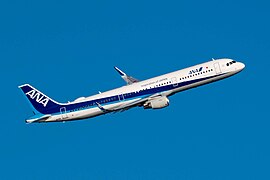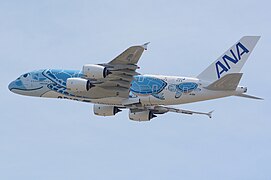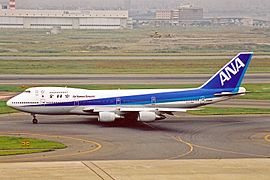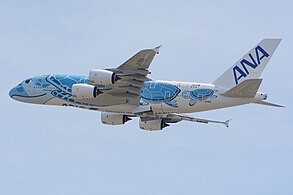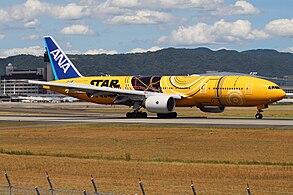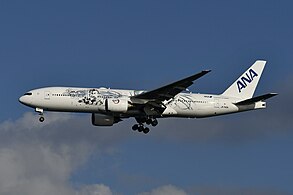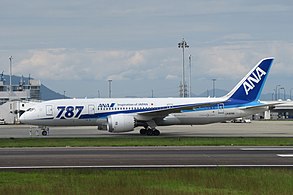Loading AI tools
All Nippon Airways Co., Ltd. (全日本空輸株式会社, Zen Nippon Kūyu Kabushiki gaisha, ANA) is a Japanese airline headquartered in Minato, Tokyo. ANA operates services to both domestic and international destinations and is Japan's largest airline, ahead of its main rival flag carrier Japan Airlines.[6] As of April 2023, the airline has approximately 12,800 employees.[7] The airline joined as a Star Alliance member in October 1999.
 | |||||||
| |||||||
| Founded | 27 December 1952 (as Japan Helicopter and Aeroplane) | ||||||
|---|---|---|---|---|---|---|---|
| Hubs | |||||||
| Secondary hubs | |||||||
| Focus cities | |||||||
| Frequent-flyer program | ANA Mileage Club | ||||||
| Alliance | Star Alliance | ||||||
| Subsidiaries | |||||||
| Fleet size | 217 [2] | ||||||
| Destinations | 92[3] | ||||||
| Parent company | ANA Holdings Inc. | ||||||
| Traded as | |||||||
| Headquarters | Shiodome City Center Minato, Tokyo, Japan[4] | ||||||
| Key people | |||||||
| Revenue | |||||||
| Operating income | |||||||
| Net income | |||||||
| Total assets | |||||||
| Total equity | |||||||
| Employees | |||||||
| Website | www | ||||||
In addition to its mainline operations, ANA controls several subsidiary passenger carriers,[8] such as its regional airline ANA Wings, Air Nippon, Air Do (a low-cost carrier operating scheduled service between Tokyo and cities in Hokkaido), Air Japan and Allex Cargo (ANA Cargo – the freighter division operated by Air Japan). ANA is also the largest shareholder in Peach, a low-cost carrier joint venture with Hong Kong company First Eastern Investment Group. On 29 March 2013, ANA was named a 5-Star Airline by Skytrax.
Formation

ANA's earliest ancestor was Japan Helicopter and Aeroplane Transports Company (日本ヘリコプター輸送, Nippon Herikoputā Yusō) (also known as Nippon Helicopter and Aeroplane), an airline company founded on 27 December 1952.[9] Nippon Helicopter was the source of what would later be ANA's International Air Transport Association (IATA) airline code, NH.[10]


NH began helicopter services in February 1953. On 15 December 1953, it operated its first cargo flight between Osaka and Tokyo using a de Havilland Dove, JA5008.[9] This was the first scheduled flight flown by a Japanese pilot in postwar Japan. Passenger service on the same route began on 1 February 1954, and was upgraded to a de Havilland Heron in March.[11] In 1955, Douglas DC-3s began flying for NH as well,[9] by which time the airline's route network extended from northern Kyūshū to Sapporo. In December 1957 Nippon Helicopter changed its name to All Nippon Airways Company.[12]
ANA's other ancestor was Far East Airlines (極東航空, Kyokutō Kōkū).[13] Although it was founded on 26 December 1952, one day before Nippon Helicopter, it did not begin operations until 20 January 1954, when it began night cargo runs between Osaka and Tokyo, also using a de Havilland Dove. It adopted the DC-3 in early 1957, by which point its route network extended through southern Japan from Tokyo to Kagoshima.[11]
Far East Airlines merged with the newly named All Nippon Airways in March 1958. The combined companies had a total market capitalization of 600 million yen, and the result of the merger was Japan's largest private airline.[9] The merged airline received a new Japanese name (全日本空輸; Zen Nippon Kūyu; All Japan Air Transport). The new united airline ran a route network that was amalgamated from its two predecessors, and the company logo of the larger NH was chosen to serve as its logo.[9]
Domestic era
| Year | Traffic |
|---|---|
| 1964 | 693 RPMs |
| 1968 | 1327 RPMs |
| 1970 | 2727 RPMs |
| 1972 | 3794 RPMs |
| 1973 | 8421 RPKs |
| 1975 | 10513 RPKs |
| 1979 | 17073 RPKs |
| 1985 | 18997 RPKs |
| 1990 | 33007 RPKs |
| 1995 | 42722 RPKs |
Source: Air Transport World
ANA grew through the 1960s, adding the Vickers Viscount to the fleet in 1960 and the Fokker F27 in 1961.[9] October 1961 marked ANA's debut on the Tokyo Stock Exchange as well as the Osaka Securities Exchange.[9] 1963 saw another merger, with Fujita Airlines, raising the company's capital to 4.65 billion yen.[9] In 1965 ANA introduced its first jet, the Boeing 727 trijet, on the Tokyo-Sapporo route. Prior to this, the Japan Civil Aviation Bureau denied an import license for ANA's 727s unless Japan Airlines (JAL) acquired their own fleet of 727s.[14] ANA also introduced Japan's first homegrown turboprop airliner, the NAMC YS-11 in 1965, replacing Convair 440s on local routes.[9] In 1969, ANA introduced Boeing 737 services.[9]

As ANA grew it started to contract travel companies across Japan to handle ground services in each region. Many of these companies received shares in ANA as part of their deals. Some of these relationships continue today in different forms: for instance, Nagoya Railroad, which handled ANA's operations in the Chūbu region along with other partnerships,[15] maintains a permanent seat on ANA's board of directors.[16] By 1974, ANA had Japan's largest domestic airline network.[13]
While ANA's domestic operations grew, the Ministry of Transport had granted government-owned JAL a monopoly on international scheduled flights[9] that lasted until 1986. ANA was allowed to operate international charter flights: its first was a Boeing 727 charter from Tokyo to Hong Kong on 21 February 1971.[17]

ANA bought its first widebody aircraft, six Lockheed L-1011s, in November 1971, following a lengthy sales effort by Lockheed which had involved negotiations between US president Richard Nixon, Japanese prime minister Kakuei Tanaka and UK prime minister Edward Heath (lobbying in favor of engine maker Rolls-Royce). Tanaka also pressed Japanese regulators to permit ANA to operate on Asia routes as part of the package.[18] The aircraft entered service on the Tokyo-Okinawa route in 1974. The carrier had ordered McDonnell Douglas DC-10s but cancelled the order at the last minute and switched to Lockheed. It was later revealed that Lockheed had indirectly bribed Prime Minister Kakuei Tanaka to force this switch: the scandal led to the arrest of Tanaka and several managers from ANA and Lockheed sales agent Marubeni for corruption.[19]
Boeing 747-200s were introduced on the Tokyo-Sapporo and Tokyo-Fukuoka routes in 1976[9] and Boeing 767s in 1983[20] on Shikoku routes. The carrier's first B747s were the short-range SR variant, designed for Japanese domestic routes.[17]
International era

In 1986, ANA began to expand beyond Japan's key domestic carrier to become a competitive international carrier as well.[9] On 3 March 1986, ANA started scheduled international flights with a passenger service from Tokyo to Guam.[21] Flights to Los Angeles and Washington, D.C., followed by year's end, and ANA also entered a service agreement with American Airlines[9] to feed the US carrier's new flights to Narita.
ANA expanded its international services gradually: to Beijing, Dalian, Hong Kong and Sydney in 1987; to Seoul in 1988; to London and Saipan in 1989; to Paris in 1990 and to New York and Singapore in 1991.[22][23] Airbus equipment such as the A320 and A321 was added to the fleet in the early 1990s, as was the Boeing 747-400 jet. ANA joined the Star Alliance in October 1999.[24]
2004 saw ANA's profits exceed JAL's for the first time. That year, facing a surplus of slots due to the construction of new airports and the ongoing expansion of Tokyo International Airport, ANA announced a fleet renewal plan that would replace some of its large aircraft with a greater number of smaller aircraft.[25]

Also in 2004, ANA set up low-cost subsidiary Air Next to operate flights from Fukuoka Airport starting in 2005, and became the majority shareholder in Nakanihon Airline Service (NAL) headquartered in Nagoya Airport.[26] In 2005, ANA renamed NAL to Air Central, and relocated its headquarters to Chūbu Centrair International Airport.[27] On 12 July 2005, ANA reached a deal with NYK to sell its 27.6% share in Nippon Cargo Airlines, a joint venture formed between the two companies in 1987.[28] The sale allowed ANA to focus on developing its own cargo division. In 2006, ANA, Japan Post, Nippon Express, and Mitsui O.S.K. Lines founded ANA & JP Express (AJV), which would operate freighters. ANA is the top shareholder of AJV. It absorbed Air Japan's freighter operations.

Air Transport World named ANA its 2007 "Airline of the Year". In 2006, the airline was recognized by FlightOnTime.info as the most punctual scheduled airline between London and Tokyo for the last four consecutive years, based on official British statistics.[29] Japan Airlines took over the title in 2007. In 2009, ANA announced plans to test an idea as part of the airline's "e-flight" campaign, encouraging passengers on select flights to visit the airport restroom before they board.[30][31] On 10 November of the same year, ANA also announced "Inspiration of JAPAN", ANA's newest international flight concept, with redesigned cabins initially launched on its 777-300ER aircraft.[32]
In July 2011, All Nippon Airways and AirAsia agreed to form a low-cost carrier, called AirAsia Japan, based at Tokyo's Narita International Airport. ANA held 51 percent shares and AirAsia held 33 percent voting shares and 16 percent non-voting shares through its wholly owned subsidiary, AA International.[33] The carrier lasted until October 2013, when AirAsia withdrew from the joint venture; the carrier was subsequently rebranded as Vanilla Air.
In March 2018, All Nippon Airways announced the integration of its two low cost carrier subsidiaries Peach Aviation and Vanilla Air into one entity retaining the Peach name; starting in the second half of FY2018 and to be completed by the end of FY2019.[34]
On 29 January 2019, ANA Holdings purchased a 9.5% stake in PAL Holdings, Philippine Airlines' parent company, for US$95 million.[35]
ANA Holdings Inc. was created in April 2013 due to the "changing landscape of the airline industry", with competition against low cost carriers cited as one of the reasons. The new holding company would have over 70 companies under it, most notably All Nippon Airways, but also low cost subsidiaries such as Peach Aviation, and other catering and ground operations companies. The holding company is led by a separate chairman and CEO.[36]
Senior leadership
- Chairman: Koji Shibata
- Chief Executive: Shinichi Inoue
List of former chairmen
- Yoji Ohashi (2013–2015)
- Shinichiro Ito (2015–2022)
- Shinya Katanozaka (2022-2024)
List of former chief executives
- Shinichiro Ito (2013–2015)
- Shinya Katanozaka (2015–2022)
- Koji Shibata (2022-2024)
President and chief executive officer
All Nippon Airways has been led by only a president and CEO since April 2013, when a new parent company was formed. The chairman of All Nippon Airways became the chairman of the holding company, and All Nippon Airways ceased to have its own chairman. The following is a list of presidents and CEOs, along with the year of their appointment:[37]
- Masuichi Midoro – 1952
- Kaheita Okazaki – 1961
- Isamu Morimura – 1967
- Tetsuo Oba – 1969
- Tokuji Wakasa – 1970
- Masamichi Anzai – 1976
- Taizo Nakamura – 1983
- Akio Kondo – 1987
- Seiji Fukatsu – 1993
- Kichisaburo Nomura – 1997
- Yoji Ohashi – 2001
- Mineo Yamamoto – 2005
- Shinichiro Ito – 2009
- Osamu Shinobe – 2013
- Yuji Hirako – 2017
- Shinichi Inoue – 2022 (current)
Headquarters

All Nippon Airways is headquartered at the Shiodome City Center in the Shiodome area in Minato, Tokyo, Japan.[38][39]
In the late 1960s ANA had its headquarters in the Hikokan Building in Shinbashi, Minato.[40] From the 1970s through the late 1990s All Nippon Airways was headquartered in the Kasumigaseki Building in Chiyoda, Tokyo.[41][42][43][44] Before moving into its current headquarters, ANA had its headquarters on the grounds of Tokyo International Airport in Ōta, Tokyo.[45] In 2002 ANA announced that it was taking up to 10 floors in the then under-construction Shiodome City Center. ANA announced that it was also moving some subsidiaries to the Shiodome City Center.[46] Shiodome City Center, which became ANA's headquarters, opened in 2003.[47]
Subsidiaries

ANA Group is a group of companies which are wholly or primarily owned by ANA. It comprises the following:[48]

Commercial aviation
- Air Japan
- ANA Wings
- Air Do (major shareholder)
- Peach (largest shareholder)
- Philippine Airlines (9.5% shareholder)
- Vietnam Airlines (8.8% shareholder)
- IFTA (Flight Training Academy training pilots for ANA Group airlines and other worldwide airlines by contract)
- Pan Am Flight Academy
General aviation
- All Nippon Helicopter (dedicated for the public broadcaster NHK.)
Hotels
- IHG ANA Hotels Group Japan (minority stake)
Discontinued
- AirAsia Japan (folded into Peach Aviation)
- Vanilla Air (merged into Peach Aviation)
- Air Hokkaido (80% shareholding, ceased operations on 31 March 2006)
- Allex Cargo (merged into Air Japan)
The following airlines merged into ANA Wings on 1 October 2010
Cargo services

As of May 2021, ANA operated a fleet of six freighter aircraft, Including four Boeing 767-300ER(BCF) and two Boeing 777F.[citation needed] ANA's freighters operate on 18 international routes and 6 domestic routes. ANA operates an overnight cargo hub at Naha Airport in Okinawa, which receives inbound freighter flights from key destinations in Japan, China and Southeast Asia between 1 and 4 a.m., followed by return flights between 4 and 6 a.m., allowing overnight service between these regional hubs as well as onward connections to other ANA and partner carrier flights. The 767 freighters also operate daytime flights from Narita and Kansai to various destinations in East and Southeast Asia.[49] ANA also operates a 767 freighter on an overnight Kansai-Haneda-Saga-Kansai route on weeknights,[50] which is used by overnight delivery services to send parcels to and from destinations in Kyushu.[51]
ANA established a 767 freighter operation in 2006 through a JV with Japan Post, Nippon Express and Mitsui, called ANA & JP Express. ANA announced a second freighter joint venture called Allex in 2008, with Kintetsu World Express, Nippon Express, MOL Logistics and Yusen Air & Sea as JV partners.[52] Allex merged with ANA subsidiary Overseas Courier Services (OCS), an overseas periodical distribution company, in 2009,[53] and ANA & JP Express was folded into ANA in 2010.[54]
ANA Cargo and the United States–based United Parcel Service have a cargo alliance and a code-share agreement, similar to an airline alliance, to transport member cargo on UPS Airlines aircraft.[55][56]
ANA also has a long historical relationship with Nippon Cargo Airlines, a Narita-based operator of Boeing 747 freighters. ANA co-founded NCA with shipping company Nippon Yusen in 1978, and at one time held 27.5% of NCA's stock. ANA sold its stake to NYK in 2005, but retained a technical partnership with NCA.[57] ANA announced in July 2013 that it would charter NCA's 747 freighter aircraft for an overnight cargo run between Narita and Okinawa, doubling capacity between ANA's key cargo hubs and freeing up 767 aircraft to operate new routes from Okinawa to Nagoya and Qingdao.[58]
On 7 March 2023, Nippon Yusen and ANA Holdings announced that ANA would acquire all shares of NCA from Nippon Yusen by 1 October 2023, or a date to be agreed by the two companies.[59][60] ANA is also considering a future merger of ANA Cargo and NCA.[59][61]
ANA has an extensive domestic route network that covers the entirety of Japan, from Hokkaido in the north to Okinawa in the south. ANA's international route network extends through China, Korea, India, Southeast Asia, Canada, United States, Mexico, Australia, and Western Europe. Its key international hub is Narita International Airport, where it shares the South Wing of Terminal 1 with its Star Alliance partners,[62] though Haneda Airport is becoming a major international hub due to its close proximity with downtown Tokyo and the mass expansions occurring there.
ANA's international network currently focuses on business destinations; its only remaining "resort" routes are its routes from Haneda and Narita to Honolulu; past resort routes such as Narita-Guam, Kansai-Honolulu and Nagoya-Honolulu have been cancelled, although ANA plans to expand resort service in the future through its low-cost subsidiary Peach Aviation.[63]
Codeshare agreements
All Nippon Airways has codeshare agreements with the following airlines:[64]
- Aegean Airlines
- Air Canada
- Air China
- Air Do
- Air Dolomiti
- Air India[65]
- Air Japan (Subsidiary)
- Air Macau
- Air New Zealand
- Amakusa Airlines[66][67]
- Asiana Airlines
- Austrian Airlines
- Avianca
- Brussels Airlines
- Copa Airlines
- Etihad Airways
- Ethiopian Airlines
- Eurowings
- EVA Air
- Garuda Indonesia
- Ibex Airlines
- ITA Airways[68]
- Japan Air Commuter[66][69]
- Juneyao Air
- LOT Polish Airlines
- Lufthansa[70]
- Oriental Air Bridge
- Philippine Airlines
- Shandong Airlines
- Shenzhen Airlines
- Singapore Airlines
- Solaseed Air
- South African Airways
- StarFlyer
- Swiss International Air Lines
- TAP Air Portugal
- Thai Airways International
- Turkish Airlines
- United Airlines[71]
- Vietnam Airlines
- Virgin Australia
Current fleet
As of September 2024[update], All Nippon Airways operates the following aircraft:[citation needed]
| Aircraft | In service | Orders | Passengers | Notes | ||||
|---|---|---|---|---|---|---|---|---|
| F | J | W | Y | Total | ||||
| Airbus A320neo | 11 | — | — | 8 | — | 138 | 146 | |
| Airbus A321-200 | 4 | — | — | 8 | — | 186 | 194 | |
| Airbus A321neo | 22 | — | ||||||
| Airbus A380-800 | 3 | — | 8 | 56 | 73 | 383 | 520 | |
| Boeing 737-800 | 39 | — | — | 8 | — | 158 | 166 | JA51AN painted in the Star Alliance livery. |
| 159 | 167 | |||||||
| Boeing 737 MAX 8 | — | 20 | TBA | Order with 10 options.[72] Deliveries begin 2025. | ||||
| Boeing 767-300ER | 15 | — | — | 35 | — | 167 | 202 | |
| 10 | 260 | 270 | Equipped with domestic configuration. JA614A painted in the Star Alliance livery.[73] | |||||
| Boeing 777-200 | 2 | — | — | 21 | — | 384 | 405 | To be retired. |
| Boeing 777-200ER | 8 | — | — | 28 | — | 364 | 392 | JA743A painted in a Star Wars C-3PO livery. JA745A painted in Demon Slayer: Kimetsu no Yaiba livery.[74] |
| Boeing 777-300 | 5 | — | — | 21 | — | 493 | 514 | To be retired. |
| Boeing 777-300ER | 13 | — | 8 | 68 | 24 | 112 | 212 | JA784A painted in "Eevee Jet NH" livery. |
| 64 | 116 | |||||||
| Boeing 777-9 | — | 20 | TBA | To replace Boeing 777-300s and 13 older Boeing 777-300ERs.[75] Two aircraft were converted to Boeing 777-8F.[72] | ||||
| Boeing 787-8 | 34 | — | — | 32 | 14 | 138 | 184 | Launch customer. JA874A painted in "ANA Future Promise" livery.[76] |
| 42 | — | 198 | 240 | |||||
| 12 | 323 | 335 | Equipped with domestic configuration. | |||||
| Boeing 787-9 | 44 | 4 | — | 48 | 21 | 146 | 215 | JA873A painted in a Star Wars R2-D2 special livery. JA871A painted in "ANA Future Promise" livery. JA894A painted in "Pikachu Jet NH" livery. Replacing older Boeing 777-200 and Boeing 777-300.[citation needed] |
| 40 | 14 | 192 | 246 | |||||
| — | 18 | 377 | 395 | Equipped with domestic configuration. | ||||
| 28 | 347 | 375 | ||||||
| Boeing 787-10 | 7 | 10 | — | 38 | 21 | 235 | 294 | Equipped with international configuration. |
| 28 | — | 401 | 429 | Equipped with domestic configuration. | ||||
| ANA Cargo fleet | ||||||||
| Boeing 767-300BCF | 5 | — | Cargo | |||||
| Boeing 767-300F | 4 | — | Cargo | |||||
| Boeing 777F | 2 | — | Cargo | [77] | ||||
| Boeing 777-8F | — | 2 | Cargo | Converted from Boeing 777-9 orders.[72] Deliveries begin 2028. | ||||
| Total | 218 | 56 | ||||||
Gallery
- All Nippon Airways current fleet
- ANA Cargo current fleet
Fleet development
On 31 July 2014, ANA firmed up orders for 7 Airbus A320neos, 23 Airbus A321neos, 20 Boeing 777-9Xs, 14 Boeing 787-9s and 6 Boeing 777-300ERs, to be used for its short and long-haul fleet renewal. Boeing valued ANA's order at approximately $13 billion at list prices.[78]
On 2 February 2015, ANA placed orders with Airbus and Boeing worth $2.2bn for three Boeing 787-10s, five Boeing 737-800s and seven Airbus A321s.[79][unreliable source?] In late July 2015, ANA entered into a secret agreement with Airbus to make additional orders in the future (number and model(s) of aircraft unidentified) in exchange for Airbus support of ANA plans to invest in bankrupt Skymark Airlines.[80]
Also in 2015, ANA placed orders for the since cancelled 15 Mitsubishi Regional Jets for regional flights, which were to be operated by ANA Wings.[81]
On 29 January 2016, ANA signed a purchase agreement with Airbus, covering firm orders for three Airbus A380s, for delivery from fiscal 2018 to operate on the Tokyo (Narita) to Honolulu route.
On 11 July 2022, ANA converted two of its 777-9 orders into the freighter variant 777-8F.[72]
Boeing 787
ANA was the launch customer for the new Boeing widebody, the Boeing 787 Dreamliner, ordering 50 examples with an option for 50 more in April 2004. ANA split the order between 30 of the short-range 787-3 and 20 of the long-haul 787-8. However, ANA later converted its −3 orders to the −8 variant.[82]
Deliveries finally began in late 2011 when ANA received its first Boeing 787 on 21 September, the first-ever Dreamliner to be delivered in the world. ANA flew its first Boeing 787 passenger flight on 26 October 2011, which operated as a charter flight from Tokyo Narita to Hong Kong.[83] ANA also became the second airline to receive the Boeing 787-9 on 28 July 2014. Despite being second, the airline preceded launch customer Air New Zealand for the first commercial flight on the 787-9, a special sightseeing charter for Japanese and American school children on 4 August.[84][85]
Historic fleet

The NAMC YS-11 was an important aircraft for All Nippon Airways, although most of them were used under the name of ANK, or Air Nippon, a subsidiary of All Nippon Airways. The final YS-11 in operation was retired in 2006.[86] Some YS-11s are in museums, or otherwise scrapped or taken apart. After a final retirement process through September 2006, all YS-11s were grounded, and obligated to retire, unless privately owned and were privately restored. The YS-11 was a big part of All Nippon Airways from the 1970s to the early 1990s when it was used on domestic operations.[86]
ANA flew its last flight of an Airbus A321-100 on 29 February 2008. This marked the end of almost ten years of operation of the Airbus A321-100, of which ANA was the only Japanese operator.[87]
All Nippon Airways had historically operated the following aircraft:[88]
Gallery
- All Nippon Airways former fleet
Former livery
The ANA former "Mohican" livery consists of a blue and white colour scheme painted as strip sections on the fuselage, with a blue vertical stabilizer with the former ANA logo. All aircraft wearing this livery are either retired or repainted. In 2010, one Boeing 767-300 was repainted in this livery.
In 1982, ANA officially introduced the "Triton blue" livery, which has a white and grey fuselage, with a blue strip painted under the windows, and the vertical stabilizer is painted blue with the word ANA painted sideways. In the first version, the Japanese name and full English name of ANA were painted black on top of windows. After joining Star Alliance, ANA gave the livery its first update, in which the airline's Japanese and English name was replaced with the ANA logo.
Current livery
Currently, ANA still uses the "Triton blue" livery, but it gives another minor update since 2010: the Japanese flag is moved near the ANA logo above the windows, and the slogan "Inspiration of Japan" is added.
Special liveries
Many ANA aircraft have operated in special liveries through the years:
- Seven jets in Star Alliance livery: two Boeing 777-200s, one Boeing 777-300ER, one Boeing 767-300ER, one Boeing 767-300, one Boeing 737-800 and one Boeing 787-9
- Twelve Pokémon-themed jets: five Boeing 747-400s, four Boeing 767-300, one Boeing 777-300, one Boeing 777-300ER [101] and one Boeing 787-9 [102]
- Four Star Wars-themed jets: one Boeing 787-9 in an R2-D2 livery; one Boeing 777-300ER in a BB-8 livery; one Boeing 767-300ER in a mixed R2-D2 and BB-8 livery; and one Boeing 777-200ER in a C-3PO livery.[103][104][105]
- Three Airbus A380-800s in ANA Flying Honu liveries (honu meaning 'sea turtle' in Hawaiian)[106][107]
- Six Demon Slayer: Kimetsu no Yaiba-themed jets: two Boeing 767-300ERs,[108][109][110] one Boeing 777-200ER from the main airline,[74] and three De Havilland Canada DHC-8 400s from the regional subsidiary ANA Wings.[111]
- Two Boeing 787s and one De Havilland Canada DHC-8 400 painted in ANA Future Promise livery to promote sustainable flying.[112][113]
- Airbus A321-100 in Landscape of Japan livery
- Airbus A380-800 in Flying Honu livery
- Boeing 737-700 in Gold Jet livery
- Boeing 737-800 in Star Alliance livery
- Boeing 737-800 in Tohoku Flower Jet livery
- Boeing 747-400 in special Pokémon (Hoenn) livery
- Boeing 747-400 in special Yellow Pokémon (Hoenn) livery
- Boeing 747-400D in Marine Jumbo livery
- Boeing 767-300 in Star Alliance livery
- Boeing 747-400D in Pokémon Pocket Monsters livery
- Boeing 767-300 in Marine Jumbo Jr livery
- Boeing 767-300 in Yume Jet You & Me livery
- ANA Boeing 767-300ER in panda livery
- Boeing 767-300 in Retro livery
- Boeing 767-300ER in Star Wars livery
- Boeing 767-300ER in Demon Slayer: Kimetsu no Yaiba livery
- Boeing 777-200 in 777 livery
- ANA Boeing 777-200 in Star Alliance livery
- Boeing 777-200ER in The New Tokyo 2020 livery
- Boeing 777-200ER in Star Wars C-3PO livery
- Boeing 777-200ER in Demon Slayer: Kimetsu no Yaiba livery
- Boeing 777-300 in "Wind" livery
- Boeing 777-300 in special Pokémon (Unova) livery
- Boeing 777-300ER in Star Wars BB-8 livery
- Boeing 777-300ER in Pokémon (Eevee) Livery
- Boeing 787-8 in special 787 launch livery
- Boeing 787-8 in special 787 launch livery
- Boeing 787-8 in Future Promise livery
- Boeing 787-9 Dreamliner in Star Wars R2-D2 livery
- Boeing 787-9 in Star Alliance livery
- Boeing 787-9 in Pokémon Livery
New cabin

This section needs additional citations for verification. (December 2023) |
Introduced in 2009, the "Inspiration of Japan" cabin features included fully-lie-flat-bed business class seats, nearly enclosed first class suite seats, fixed shell back seats in both of its economy classes, a new AVOD in-flight entertainment system (based on Panasonic Avionics Corporation's eX2 IFE system with iPod connectivity, in-seat shopping and meal ordering as well as cabin touchscreen consoles) as well as improvements to its in-flight service. ANA will also introduce a new lounge (which opened on 20 February 2010, supposed to be in coincidence with the introduction of new aircraft interiors but delayed [see below]) and check-in concept (later in autumn 2010) at Narita for first class and ANA Mileage Club's Diamond Service elite members.[citation needed]
The introduction of the concept also discontinued the use of the name "Club ANA", which was used for its international business class seats (changing into a generic business class name) as well as the name of the lounges (all lounges for both first class and business class are named "ANA Lounge", with the first class lounge called the "ANA Suite Lounge" and its arrival lounge the "ANA Arrival Lounge").[citation needed]

This "Inspiration of Japan" concept was originally set to debut on 20 February 2010 with the delivery of its new Boeing 777-300ER prior to that date, followed by the introduction of the concept on that date on the Narita-New York route. However, due to delays to the new premium economy seats, the debut was pushed back to 19 April. (The delay was due to the failure of a safety test in Japan of a new seat design axle, made by seat manufacturer Koito Industries Ltd. This safety test failure also affected deliveries of aircraft to be operated by three other fellow Star Alliance members – Singapore Airlines for its A380s, Thai Airways' A330s, and Continental Airlines for new 737-800 deliveries.[114][115])
The "Inspiration of Japan" concept has been refitted on its existing 777-300ERs for service on all the airline's North American routes,[116] and may be refitted on its European routes. Parts of it may eventually be phased into its existing Boeing 767-300ERs in service as well as the upcoming Boeing 787s in order.[32][117][118][119]
Since February 2010 ANA offers women's-only lavatories on international flights.[120] The first Boeing 787 the airline received have the bidets in both economy and business class lavatory.[121]
Inflight magazine
ANA's inflight magazine is named Wingspan and is available both on board and as a freely downloadable application for Apple's iPad. The iPad version is named Virtual Airport and includes content from Wingspan as well as links to airline booking and online check-in pages.[122]
Bus shuttle services
Previously ANA had a dedicated shuttle bus from Düsseldorf to Frankfurt Airport so passengers may board ANA flights at that airport, but the bus service was discontinued after ANA began its dedicated Düsseldorf flights in 2014.[123][124]

- ANA sponsored the film Happy Flight, which is about a co-pilot and flight attendant on an ANA flight to Hawaii.[125]
- ANA was featured in Miss Pilot, a Japanese television drama about a female pilot.
- ANA sponsored the Japanese television drama Good Luck!!, which is about a group of airline crew members. The series starred Takuya Kimura, Shinichi Tsutsumi and Kou Shibasaki.
- The title for All Nippon Air Line, a Josei manga by Kei Azumaya that was inspired by All Nippon Airways.
- Some of ANA's aircraft were Pokémon themed. Special exclusive promotional cards were also given out to passengers during certain Pokémon marketing campaigns. As of 2016, most of ANA's Pokémon themed jets have been either retired or repainted. In 2023, ANA reintroduced the Pokémon themed jets with a Boeing 787-9 (JA894A) and a Boeing 777-300ER (JA784A) after 7 years.[126]
- The fictional airline All Korea Airlines featured in the SBS Drama Vagabond, sports similarities to ANA in regards to its name and logo.
- The airplane-crash set built for War Of The Worlds; now featured in Universal Studios Hollywood's Studio Tour was one of ANA's retired Boeing 747-100SR registered as JA8147. It was dismantled into several pieces for the film and still bears the ANA livery with its titles removed.[citation needed]
- On 12 August 1958, Flight 025, a Douglas DC-3 (JA5045), crashed 17 km (11 mi) off Toshima, one hour after takeoff from Tokyo en route to Nagoya, killing all 33 on board.[127]
- In 1958, dynamite was planted in a Douglas DC-3 by Akira Emoto, a candy salesman, as part of a suicide plan. Emoto killed himself by leaping from the aircraft and the bombs failed to detonate.[128]
- On 16 March 1960, Douglas DC-3 JA5018 was taxiing after landing at Nagoya-Komaki International Airport when North American F-86D Sabre 94-8137 of the Japan Air Self-Defense Force (JASDF) collided with its aft fuselage and tail section while attempting to take off, killing 3 of 33 on board. Although the Sabre crashed and burned, the pilot survived.[129]
- On 12 June 1961, Vickers Viscount G-APKJ was written off when the starboard undercarriage collapsed following a heavy landing at Osaka Itami Airport.[130]
- On 19 November 1962, Vickers Viscount JA8202 crashed at Nagoya while on a training flight due to possible pilot error, killing all four crew on board.[131]
- On 30 April 1963, Douglas DC-3 JA5039 crashed at Hachijojima Airport due to locked up brakes; both pilots survived, but the aircraft was damaged beyond repair.[132]
- On 10 May 1963, DC-3 JA5040 crashed at Sendai.[133]
- On 5 June 1963, DC-3 JA5027 swerved off the runway on takeoff at Osaka-Itami Airport and struck the rear of a second DC-3 (JA5078); JA5078 was written off while JA5027 was repaired with parts from DC-3 JA5039.[134]
- On 14 February 1965, DC-3 JA5080 struck Mount Nakanoone at 2,200 m (7,200 ft), killing both pilots; the wreckage was located on 29 December 1966.[135]
- On 4 February 1966, Flight 60, operated by Boeing 727 JA8302, was on approach to Tokyo Haneda Airport when it crashed into Tokyo Bay for reasons unknown, killing all 133 passengers and crew. Following this accident, all passenger aircraft operating in Japan were required to be equipped with cockpit voice recorders and flight data recorders.[136]
- On 13 November 1966, Flight 533 operated by a NAMC YS-11, crashed in the Seto Inland Sea off Matsuyama following an unexplained loss of altitude while attempting to go-around, killing all 50 on board.[137]
- On 30 July 1971, Flight 58, operated by a Boeing 727-200 (JA8329), collided with JASDF F-86F Sabre 92-7932 that was on a training flight; the right wing of the F-86 struck the left horizontal stabilizer of the 727 and both aircraft crashed out of control, killing all 162 on board the 727; the F-86 pilot ejected and survived.[138]
- On 22 June 1995 a man calling himself "Fumio Kujimi" and registered with ANA as "Saburo Kobayashi" hijacked Flight 857, a Boeing 747SR, after it took off from Tokyo. The aircraft landed in Hokkaidō where it was stormed by police, arresting the hijacker.[139] Police stated that the hijacker was 53-year-old Fujio Kutsumi;[140] he had demanded the release of Shoko Asahara.[141] The hijacking incident lasted 16 hours.[140]
- On 23 July 1999, a man hijacked Flight 61 and killed the captain. He was subdued by other crew members, and no passengers or other crew were killed or injured.[142]

- On 13 March 2007, Flight 1603 departed Itami Airport to Kochi Airport, where the Bombardier DHC-8-402 landed without its nose landing gear, causing damage to the nose. None of the 60 passengers and crew on board were injured. The failure for the landing gear to extend was determined to be from the landing gear doors not opening due to missing parts.[143][144][145]
- On 6 September 2011, Flight 140, operated by a 737-700 traveling from Naha to Tokyo with 117 passengers and crew, banked over 90 degrees in mid-air and rapidly descended as the first officer inadvertently rotated the rudder trim switch instead of the door unlock button as the captain returned from the lavatory. The first officer eventually regained control and leveled the aircraft. There were minor injuries to two flight attendants.[146]
- On 16 January 2013, Flight 692, a Boeing 787 flying from Yamaguchi Ube Airport to Tokyo Haneda Airport reported a battery problem while climbing to FL330. The pilots made an emergency landing at Takamatsu Airport. No casualties were reported during the evacuation. However, after this incident, all 787s were subsequently grounded by aviation authorities until the battery issue was resolved.
- On 13 January 2024, Flight 1182, a Boeing 737-800 traveling from Sapporo to Toyama reported a crack in the cockpit window while passing over the city of Hakodote in Hokkaido. It landed back at Sapporo's New Chitose Airport at 12:10 local time (03:10 GMT) with no fatalities or injuries.[147][148]
- Aviation
- Air transport in Japan
- List of airports in Japan
- List of Japanese companies
- Transport in Japan
- Yokohama Flügels, former football club
- Oriental Land Company (0.18%)
Wikiwand in your browser!
Seamless Wikipedia browsing. On steroids.
Every time you click a link to Wikipedia, Wiktionary or Wikiquote in your browser's search results, it will show the modern Wikiwand interface.
Wikiwand extension is a five stars, simple, with minimum permission required to keep your browsing private, safe and transparent.



